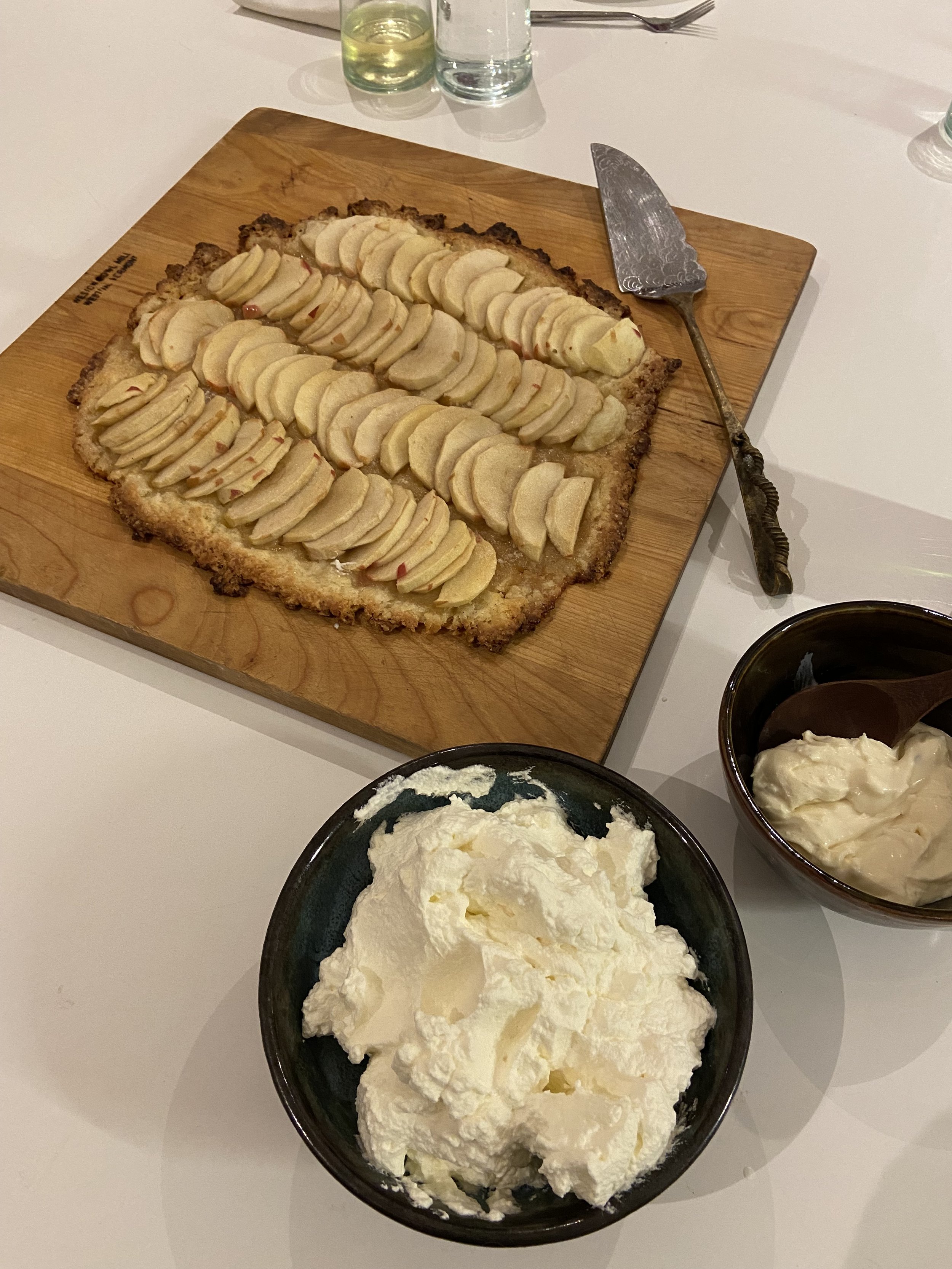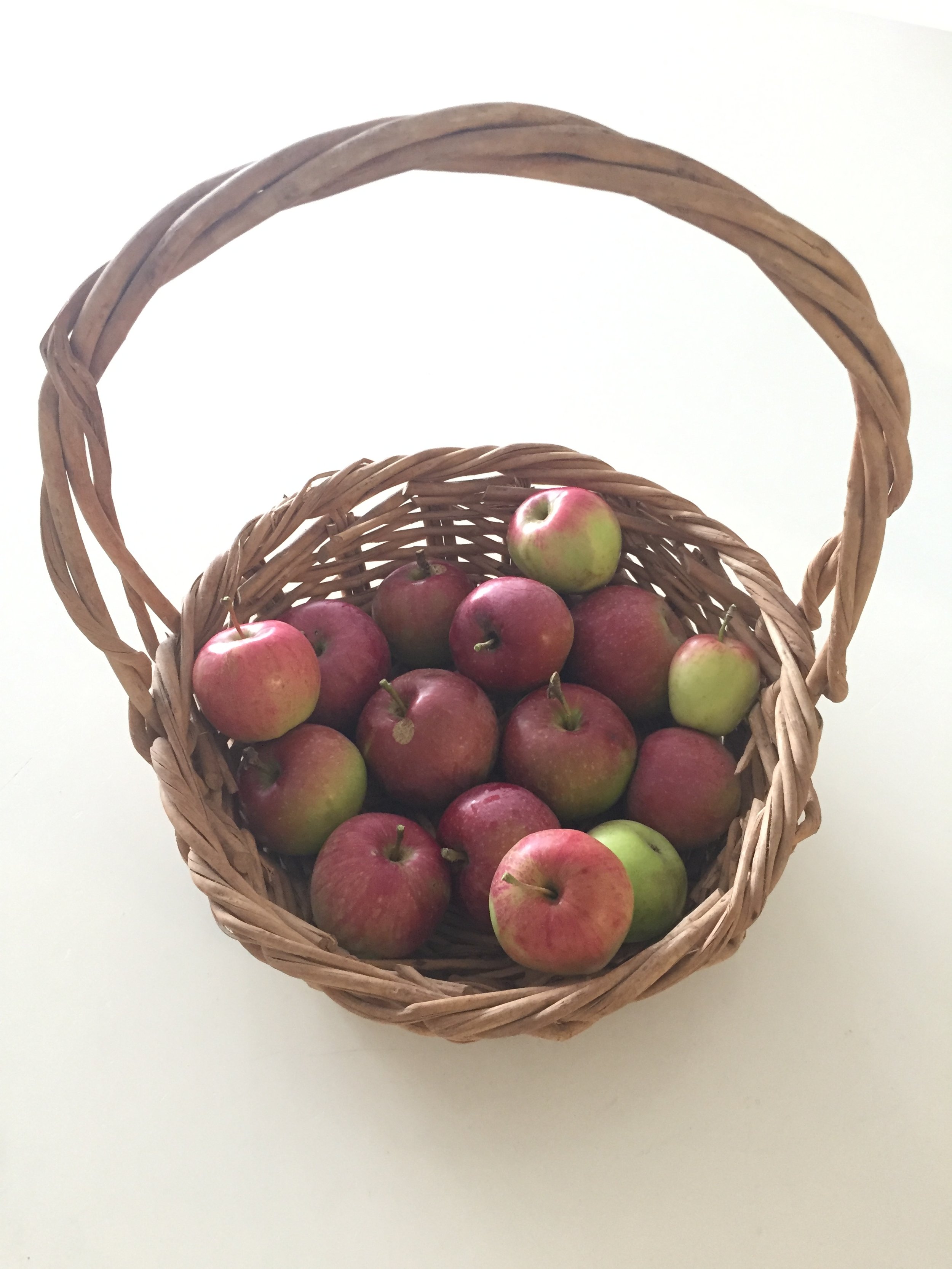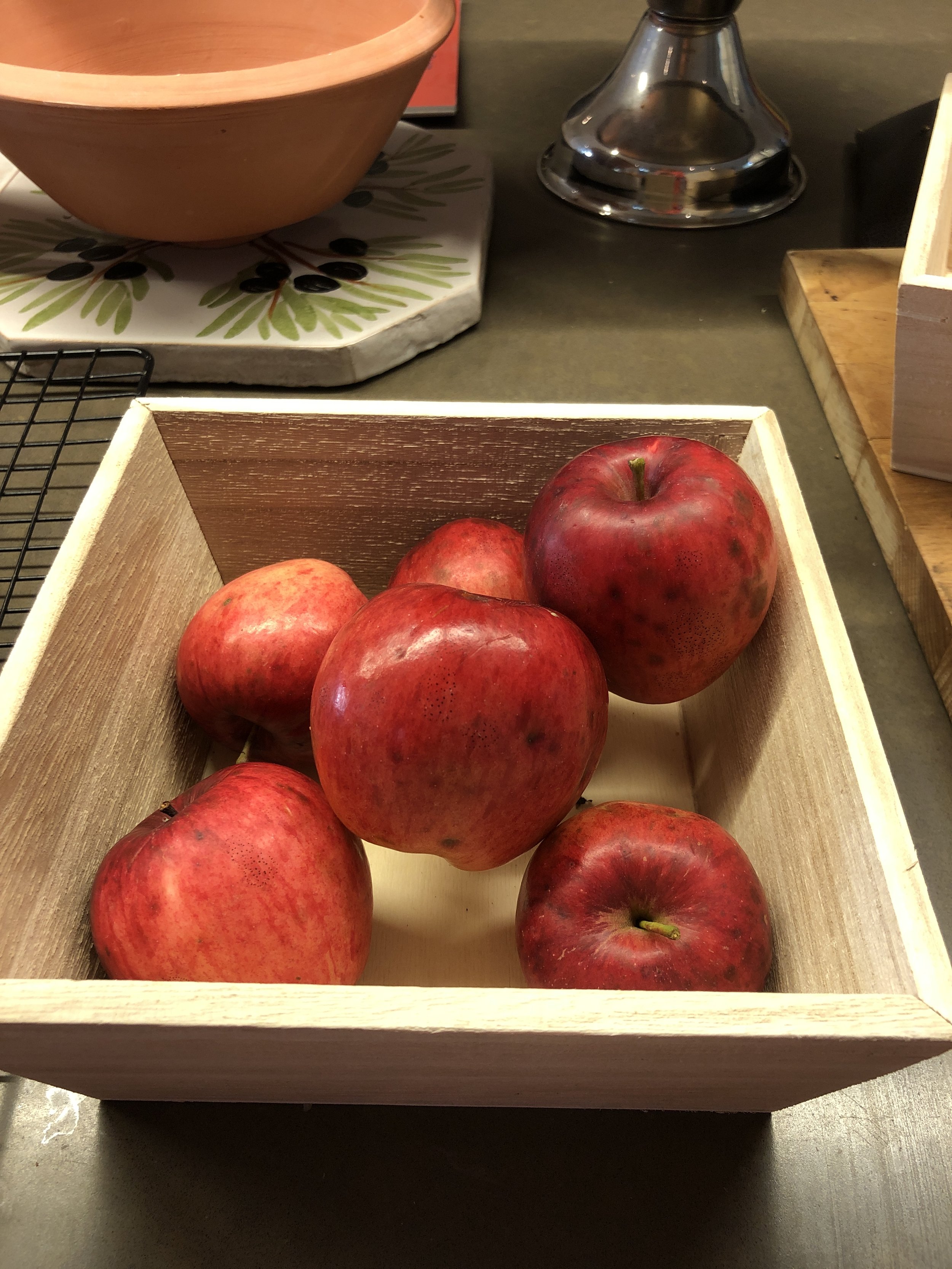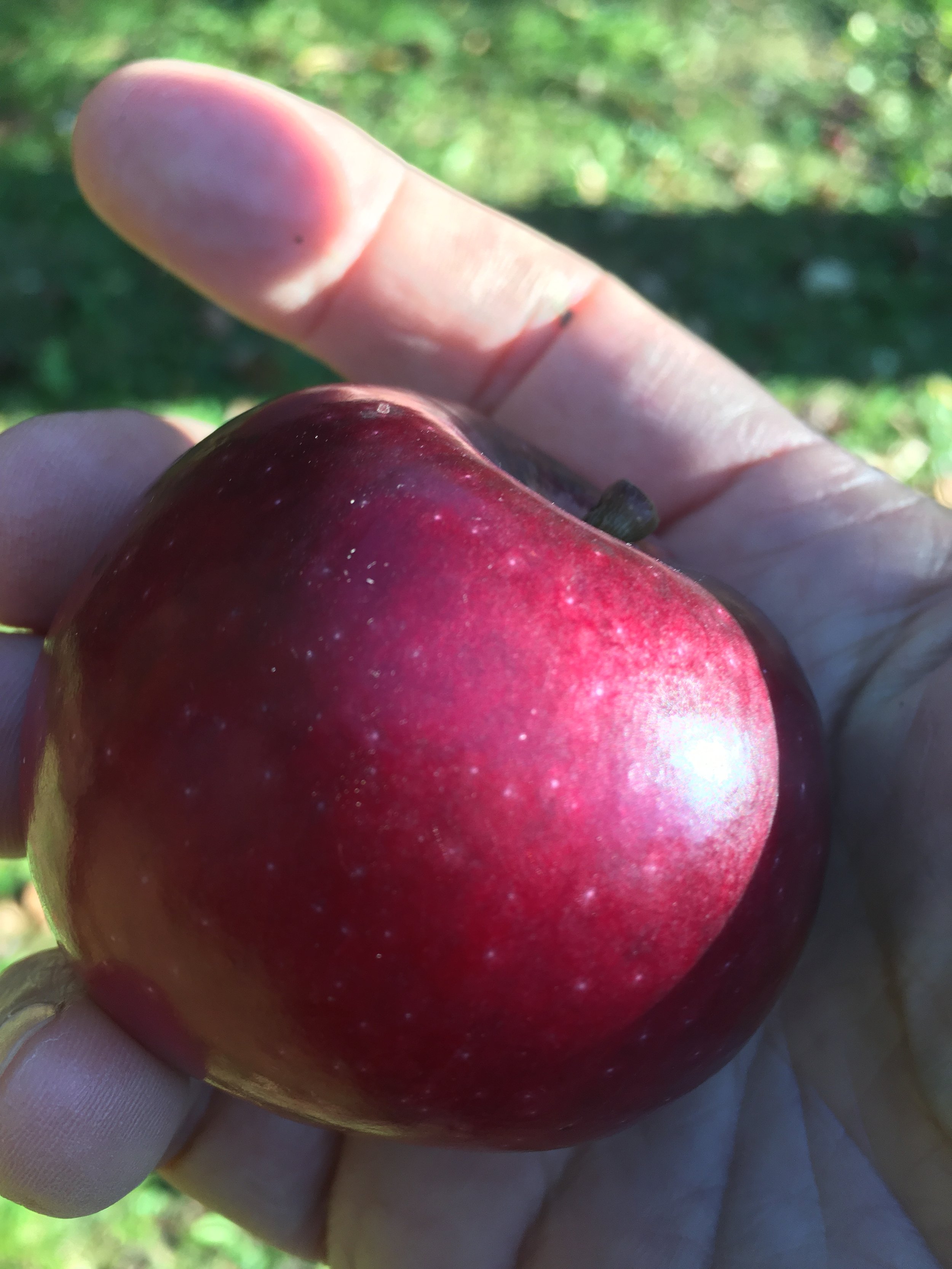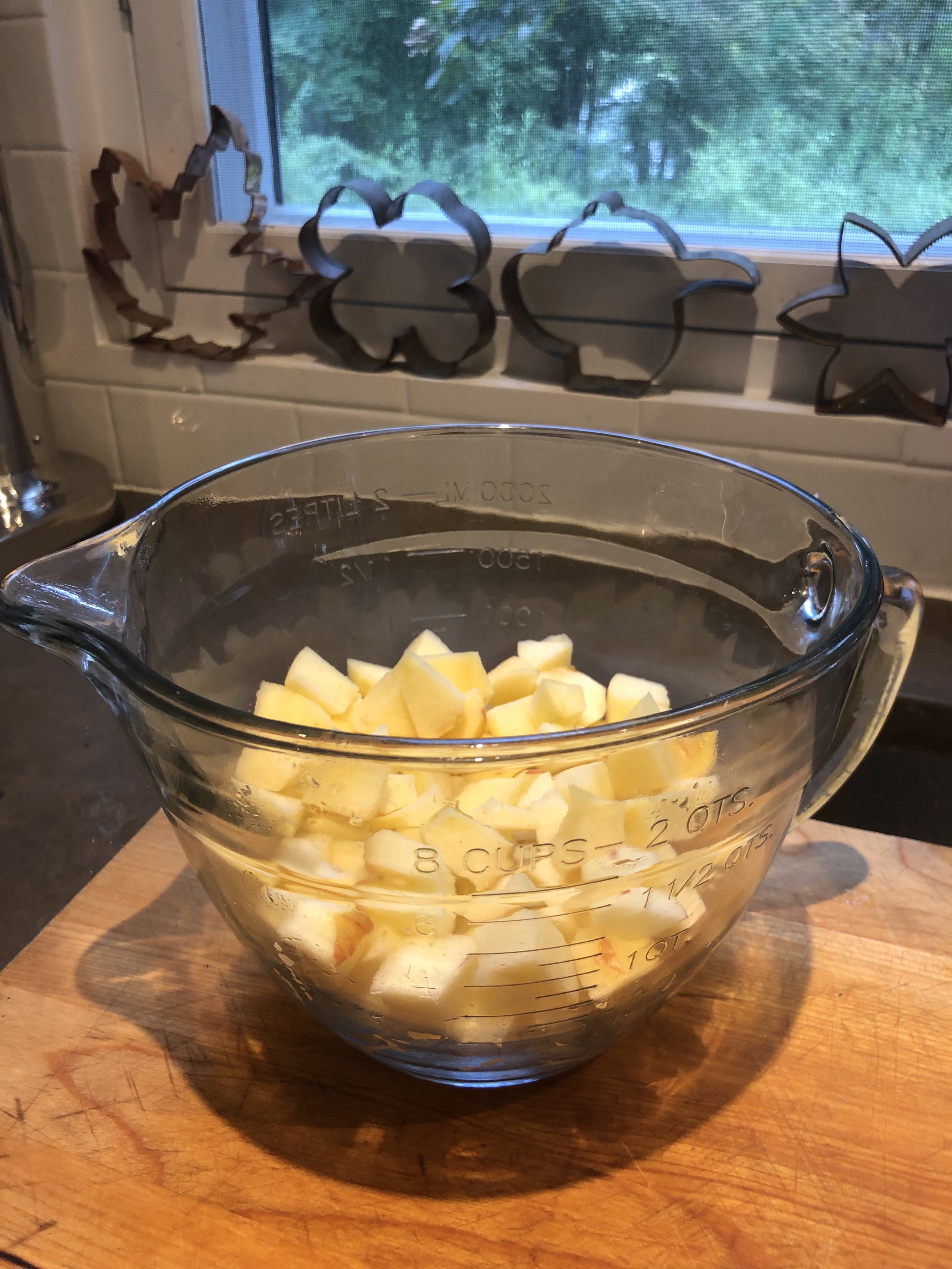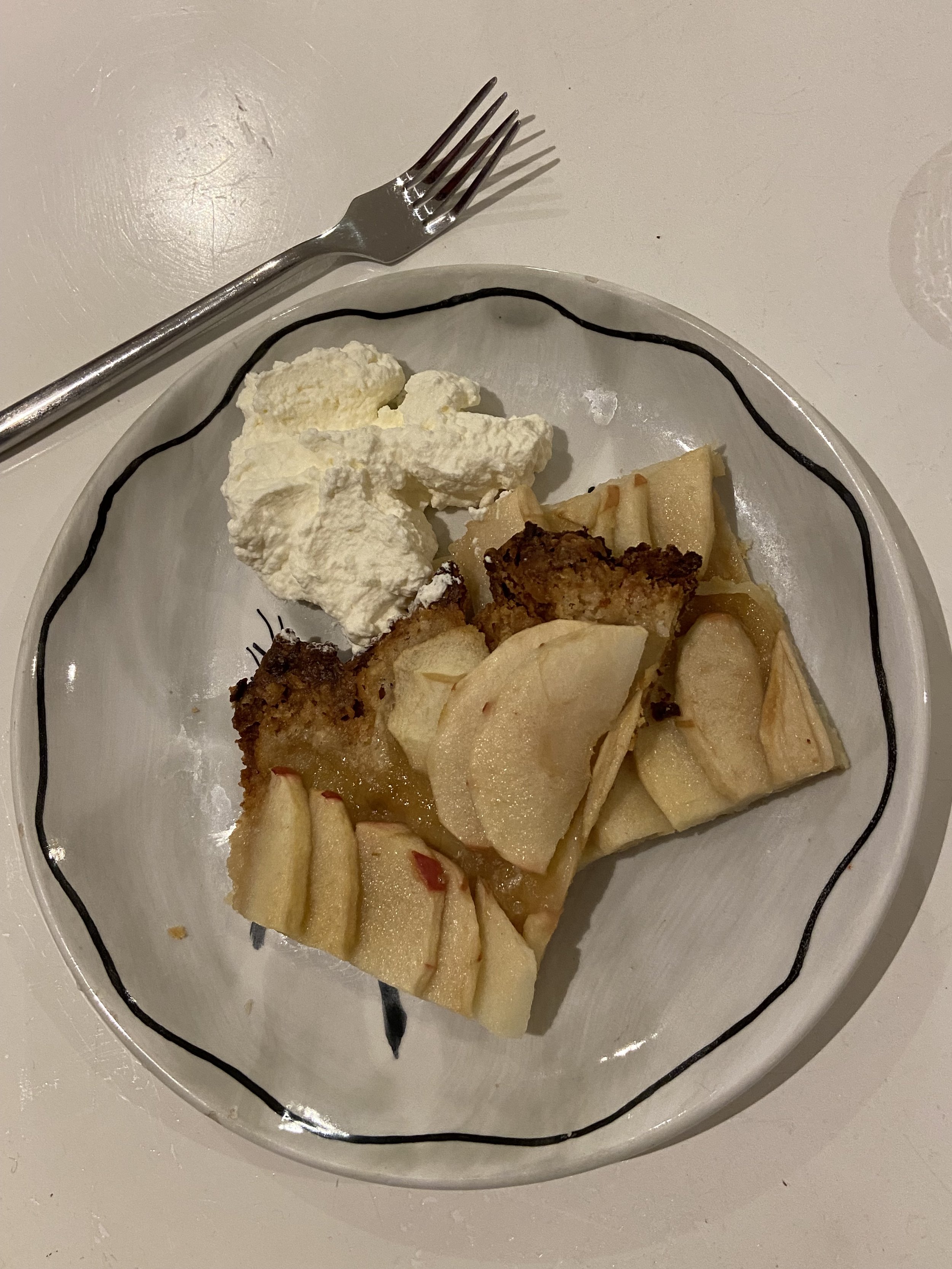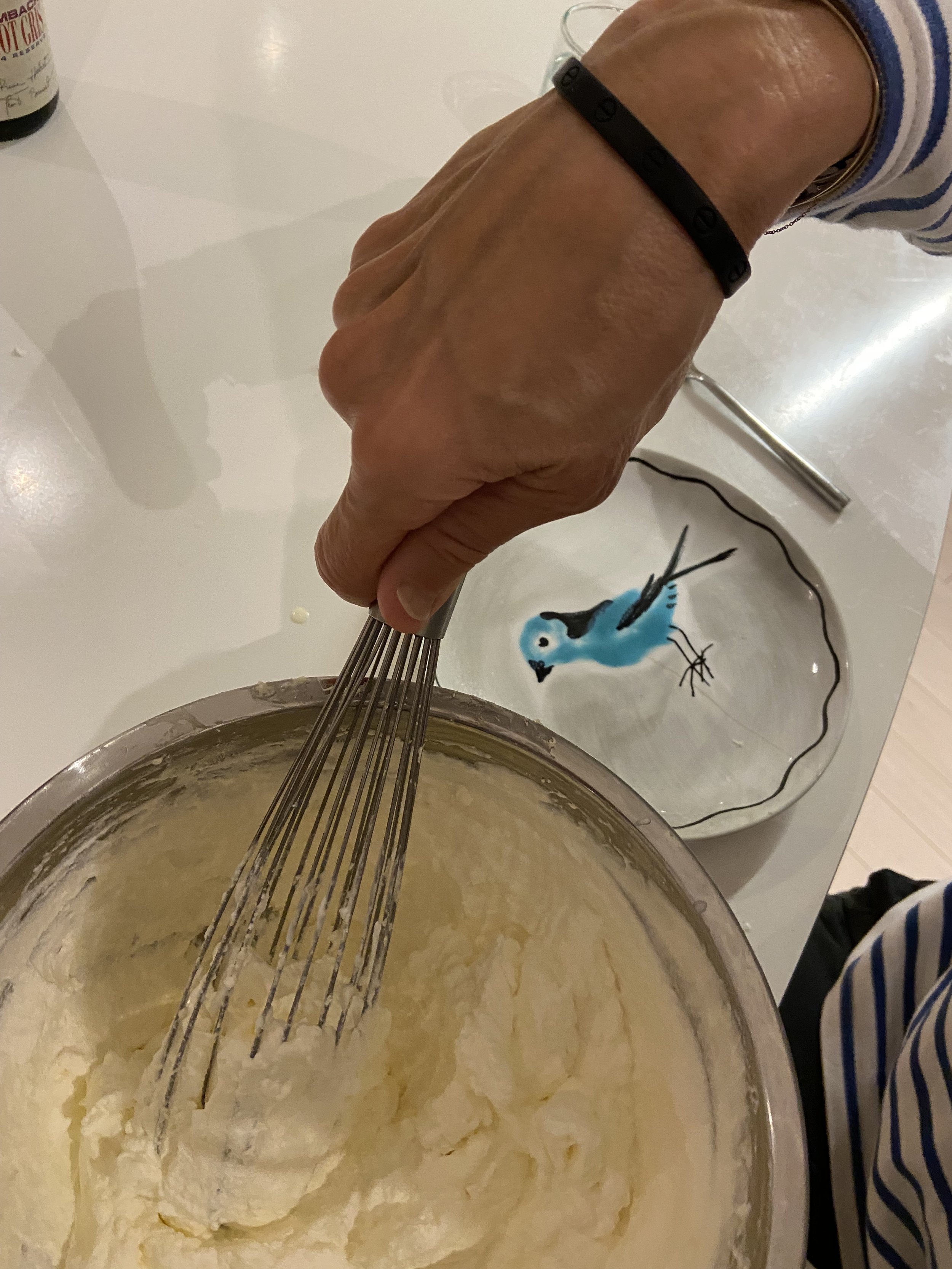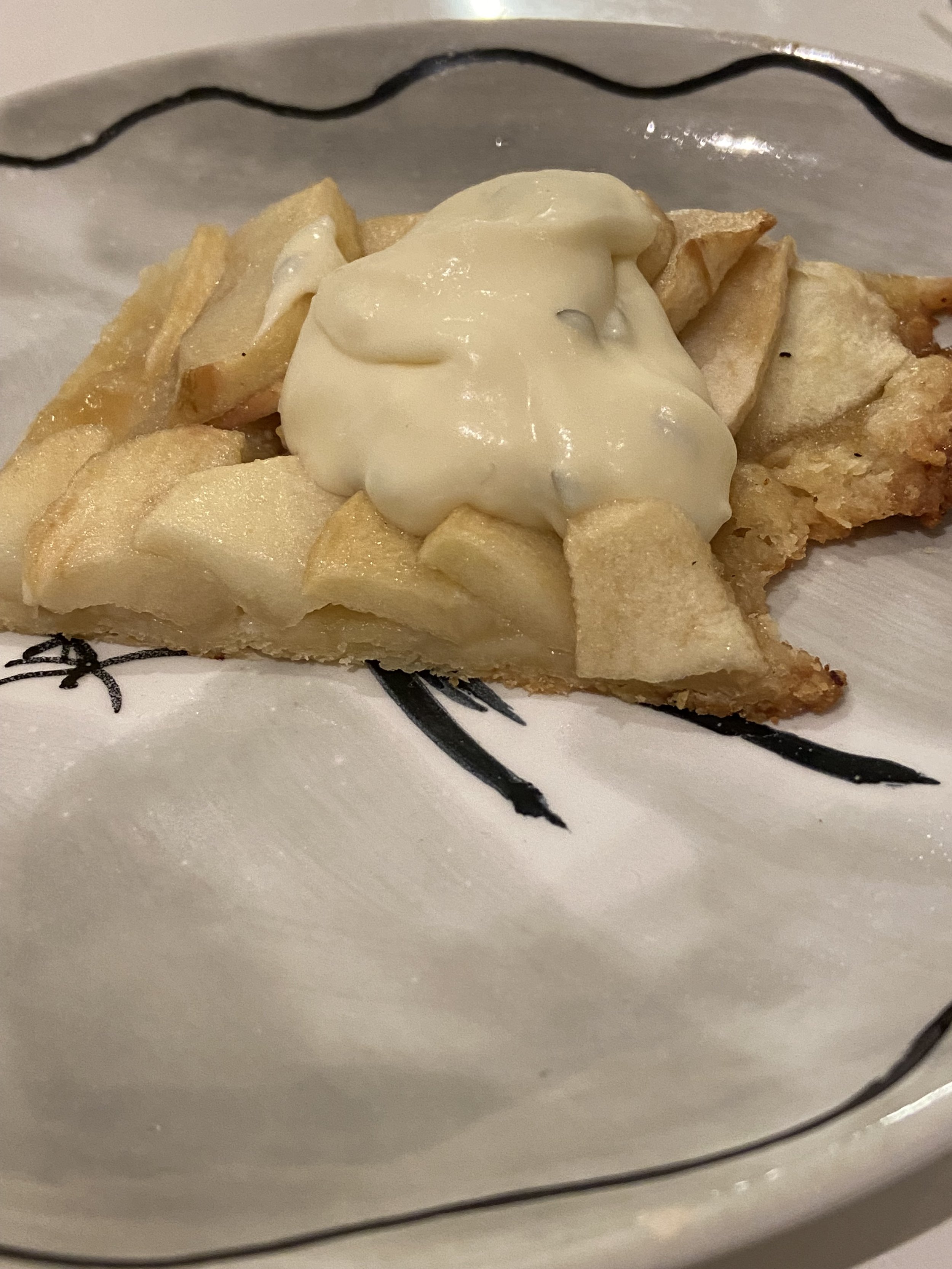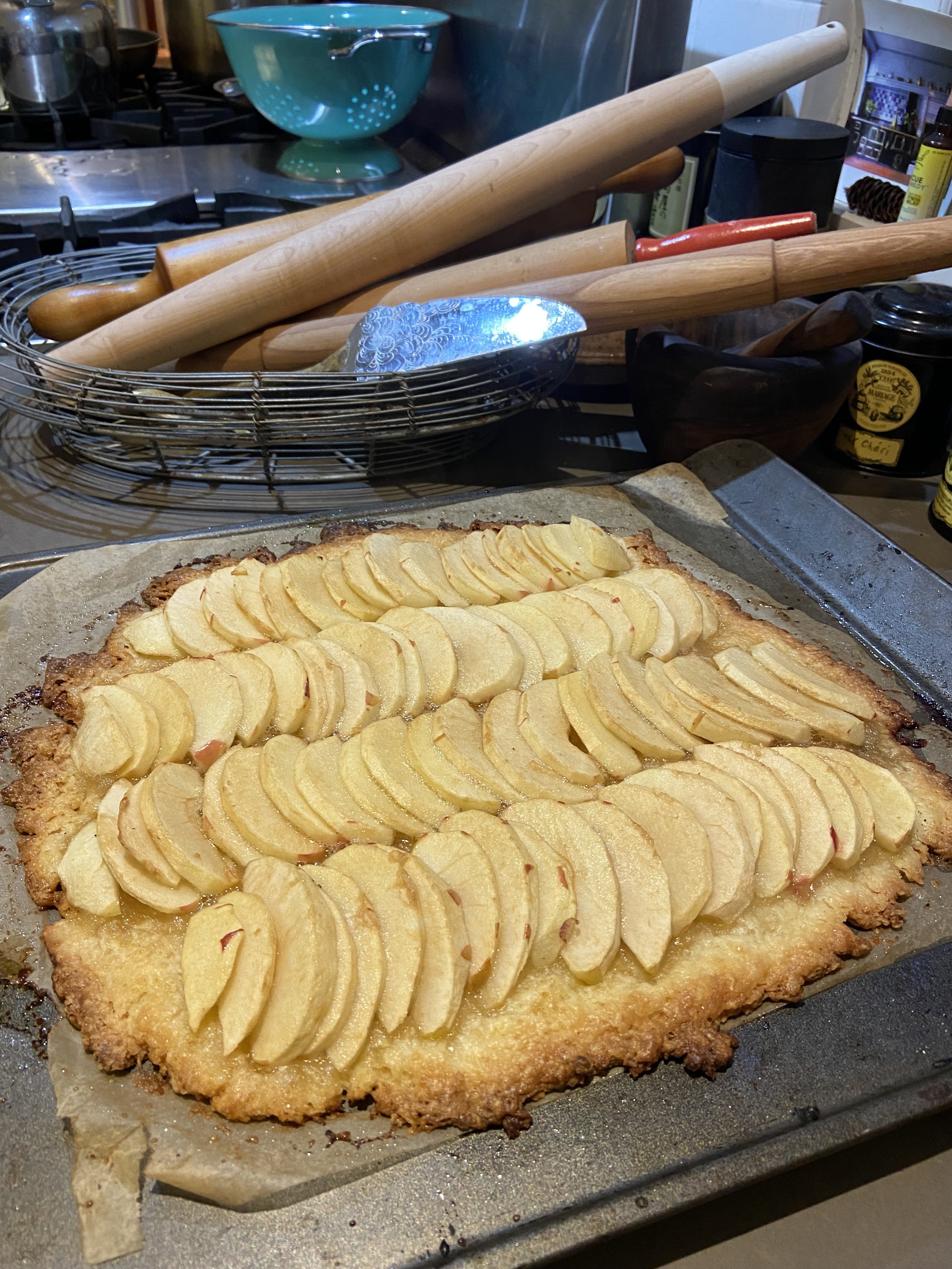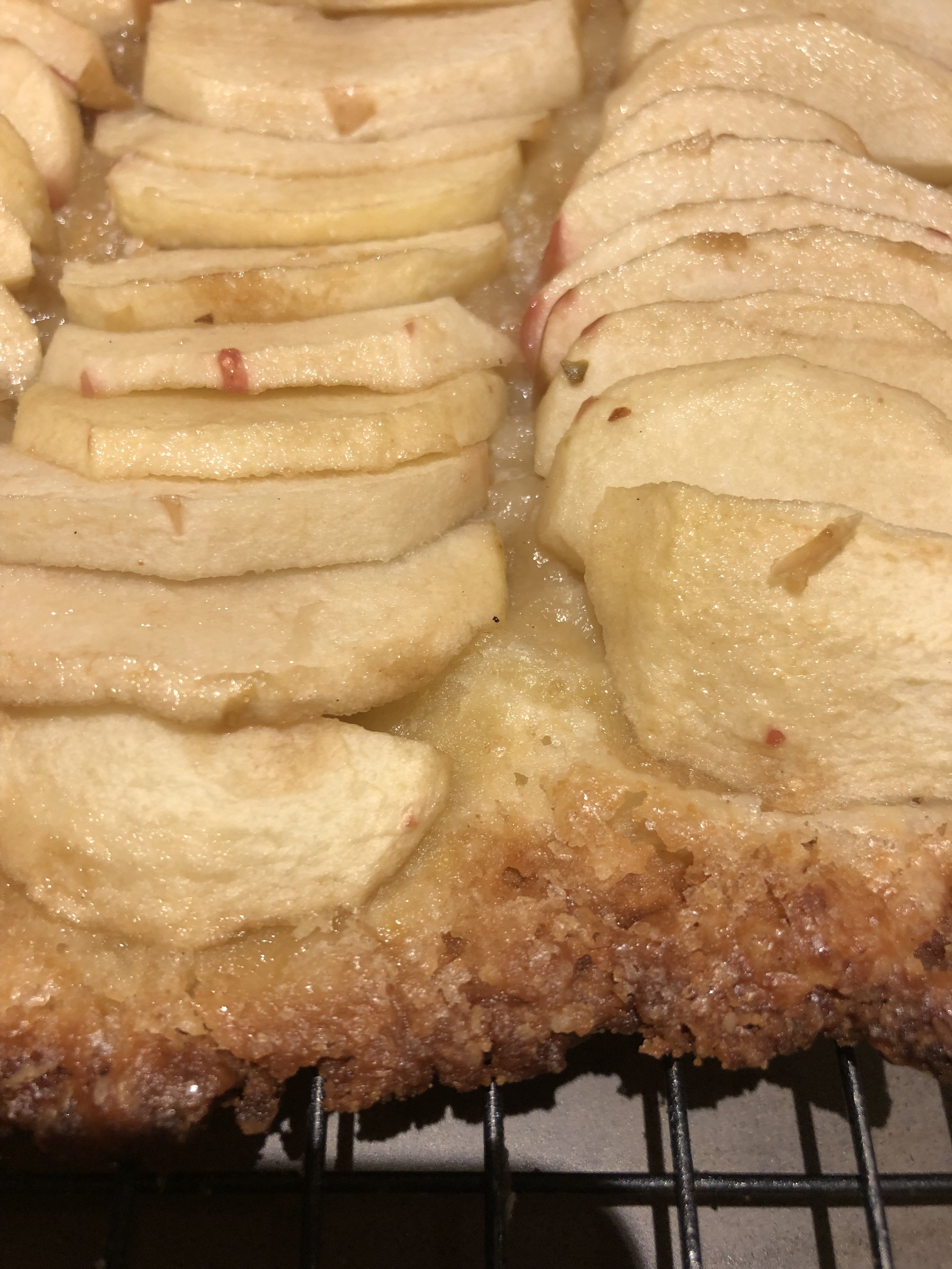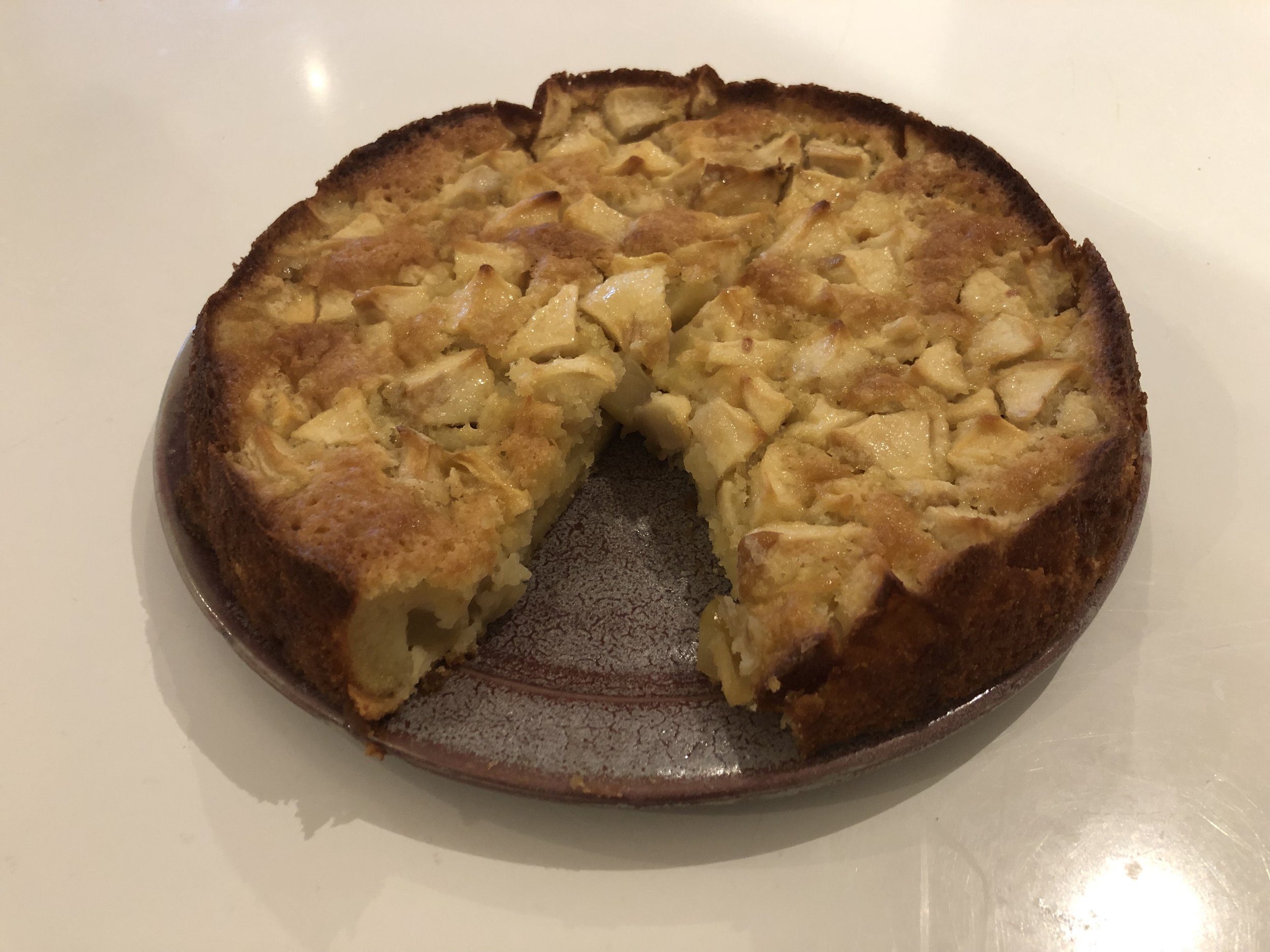Apples to Apples
What more is there really to say about the apple? That humble orb, shiny and ubiquitous -- 24/7, 365 at your local bodega, big box supermarket, fanciest of food emporia, farmer’s market, gas station. Many decades ago, an alumna at my alma mater bequeathed a bowl of apples in every house on campus, in perpetuity. An apple a day… the apple of my eye… one bad apple… shall I go on? But here we are. Because, the seasonal consideration of the apple, is, well, as American as apple pie. And consider this: there are 7,500 varieties of apples grown throughout the world, 2,500 in the United States alone.
I am lucky enough to gaze daily out my window at trees bearing four of those varieties. Macoun, MacIntosh, Gala, and the heirloom Black Oxford. Dark, thin skinned burgundy wine-stained, green-hued flesh striated pink, sweet, tart, juicy. If there’s a perfect apple, this is it. Some years they are so bountiful even the wildlife can’t keep up. Our dogs play with them like so many tennis balls – becoming woozy and sleepy after biting into one too many languishing on the ground, fermenting and turning to alcohol. We’ve also witnessed deer dozing beneath the trees. And so, during the fall, peak apple season, I use them at every turn, because what’s more magical than walking out the door and harvesting your own bounty, even if it’s a workaday apple?
First, an admission. As a baker, I am not a fan of a traditional American apple pie. (I don’t like American football either. Let’s just get that out of the way). I always find it some combination of gloppy, goopy, cloyingly sweet, the fruit’s true essence lost in a heavy puddle of sugar, binding starch, and spices. Maybe it’s a slightly Proustian thing; after growing up in Europe and Asia, my memory of the apple is that a pie should smell, and taste, well, like an apple.
So when I saw Mark Bittman’s recipe for an apple galette, now years ago, in the New York Times, I had a moment. The simplicity of the recipe, the ease with which it comes together every time, no matter the humidity or air temperature, crust flat or gently nudged, pulled, and pleated up and over to cradle the fruit, slicked with an egg wash and dotted with thick sugar crystals, or not, any kind of apple, sliced thick or thin, peeled or not. It’s the imprecision that I love – the forgiveness, the rugged beauty of the creases and crags of the crust, the way the apple shines through, aromatic, unembellished, always recognizable, no need to dress it up. Accessorize it with a dollop of crème fraîche, or soft, vanilla-essenced whipped cream, or really good, really softened, vanilla ice cream and voilà, you have a winner every time, the star of the show. If you’re feeling magnanimous, you can offer an apology to your husband who spent many more hours contemplating, shopping for, and creating the extraordinary dinner that preceded it.
And then. And then! Just when I thought nothing could top the galette, a few years later I came upon a David Lebovitz blog post adapting Dorie Greenspan’s recipe for French Apple Cake. Ok. So. Much like I am not a fan of apple pie, I am not a fan of apple cake, or any fruit-filled cake. Or cake. Until now. I like crunch, I like texture. I like layers, I like flavors to unfold and sequentially reveal the butter, the flake, the sweet, the savory, the grain, the crumb. But there was something about this cake drew me in. Let’s be clear, the recipe had me at “apple” and I wanted to try something new with the copious and varied apples on hand. And too, this cake calls for a mix of apples. And as much as my family loves my galette, at a certain point they start to revolt – much as Maine prisoners revolted against too much lobster on the menu in colonial times when the crustacean was considered a poor person’s protein. So plentiful it was on and off the shores of New England, some servants in Massachusetts stipulated in their contracts that they be fed shellfish no more than twice a week.
But back to the French Apple Cake. Sweet, soft, bursting with tiny, velvety apple pillows, the flavor caramel-y, maple-y, redolent of a crisp fall day and a warm night by the first fire of the season. And just out of the springform pan it yields a super thin, slightly caramelized outer edge – thus fulfilling my crust mandate, no matter how marginal. The original recipe calls for dark rum – very French, think baba au rhum. But I prefer to use something lighter, aromatic in a different way, again redolent of a bracing New England fall day: maple liqueur. Conveniently, there’s a local distillery not far down the road from my mother’s home in Vermont, where I stock up on Metcalfe’s Maple Liquer.
Fruit-filled cakes can be tricky— damp, soggy, brick-like; clafoutis not right can be eggy, heavy, bland. But the ease and consistency with which this cake comes together, the floral fragrance that wafts through the house as it bakes, makes it a keeper. And so far, no revolt. The steps may seem onerous and persnickety at first, adding half of this, folding in half of that, once and again, but trust me. This cake is transcendent.
FREE-FORM APPLE GALETTE
(adapted from Mark Bittman’s Free-Form Apple or Pear Tart, New York Times)
INGREDIENTS:
• 1 ¼ cups all-purpose flour (chilled in bowl in freezer along with sugar and salt while you gather remaining ingredients)
• Pinch salt
• 3 tablespoons sugar
• 8 tablespoons cold butter, cut into small chunks, plus 2 tablespoons for topping
• 3 to 4 tablespoons ice cold water
• 1 egg yolk from 1 large egg
• 4-5 apples, depending on size, peeled, cored, and thinly sliced
• 2 tablespoons brown, demerara, or turbinado sugar
• Crème fraîche, vanilla-essenced whipped cream, or softened vanilla ice cream
METHOD:
Combine chilled flour, sugar, and salt in a food processor, or whisk together in a large bowl. Add the 8 tablespoons butter and egg yolk and process for about 10 seconds, or use pastry blender until mixture looks chunky and sandy; you want to see small bits of flour coated butter. If using processor, turn mixture into a bowl.
Drizzle in cold water, 1 tablespoon at a time, stirring well with a fork after each addition. After adding 3 or 4 tablespoons you should be able to gather mixture into a ball. Be careful not to over water -- errant crumbs are ok! Turn dough onto a sheet of plastic wrap, knead a few times, flatten into a disc, wrap tightly, and refrigerate for at least an hour (or freeze for about 15 minutes). Feel free to make dough a few days ahead (in which case you can freeze the flour mixture for about 15 minutes before adding other ingredients).
Preheat oven to 400ºF . Line a cookie sheet with parchment paper or a Silpat. Roll dough into a rough 12- to 14- inch circle. (I find it easiest to roll out the dough directly on the parchment or Silpat and transfer the whole thing onto the cookie sheet intact). If dough becomes too soft, return to fridge for 10 minutes or so. Arrange fruit slices on top, right out to edges, as precisely or imprecisely as you would like. Sprinkle with brown sugar, and chop and top galette with the remaining 2 tablespoons of butter.
Bake until crust is nicely browned along the edges, and fruit is tender, 25 to 30 minutes. Remove, and serve warm or at room temperature, cut into slices or squares, with crème fraîche, vanilla-essenced whipped cream, or softened vanilla ice cream.
Yield: 8-10 generous slices, or my preferred way to serve: 12 neat squares. Best eaten day it is prepared, but it will keep for a few days, tightly wrapped on counter or in fridge.
FRENCH APPLE CAKE
(adapted from David Lebovitz)
INGREDIENTS:
¾ cup flour
¾ teaspoon baking powder
Pinch salt
Scant 3 ½ cups apples, chopped into 1-inch chunks (approximately 4 apples of mixed varieties, depending on size)
2 large eggs, room temperature
¾ cup sugar
3 tablespoons maple liqueur (or dark rum, or whatever liqueur or eau de vie you have on hand). For an alcohol-free version, try 1 to 2 teaspoons alcohol-free vanilla extract, or ¼ to ½ teaspoon maple flavoring)
½ teaspoon vanilla extract
8 tablespoons butter, melted and cooled to room temperature
METHOD:
Preheat oven to 350ºF, and center rack in oven.
Heavily butter a 9-inch springform pan.
In a small bowl, whisk together flour, baking powder, and salt.
Peel and core the apples, and cut into 1-inch chunks. You should have a scant 3 ½ cups once chopped.
Using a stand mixer or a large bowl, whisk the eggs until foamy, then whisk in sugar, maple liqueur, and vanilla, one at a time, until well combined. Whisk in ½ of the flour mixture. Using a silicone spatula, gently stir in half of the melted butter. Carefully stir in remaining flour, followed by rest of butter. Fold in the apples until they are well-coated, then scrape batter into your springform pan. The batter will be thin. Do not despair!
Bake cake for 50 minutes to an hour, rotating pan half way through. The cake is done when a knife inserted in center comes out clean.
Let cool on rack for 5 minutes, then carefully run a knife around perimeter, making sure no apple bits get left behind, before gently removing sides of pan. Let cake cool to room temperature, and serve with a generous dollop of crème fraîche, softly whipped cream, or softened vanilla ice cream.
Yield: 1 9-inch cake, which can be cut into a comfortable 8 slices, best baked and eaten the same day. The original recipe claims leftovers will keep under a cake dome or inverted bowl on the counter for a few days, but this has never once occurred in my household so I can’t vouch for it.
Suzi Schiffer Parrasch is a reformed network television news producer who, when not foraging for apples, bakes, runs, skis, writes, edits, and consults (even when no one is asking).


